Servicios Personalizados
Revista
Articulo
Indicadores
-
 Citado por SciELO
Citado por SciELO -
 Accesos
Accesos
Links relacionados
-
 Citado por Google
Citado por Google -
 Similares en
SciELO
Similares en
SciELO -
 Similares en Google
Similares en Google
Compartir
Ingeniería e Investigación
versión impresa ISSN 0120-5609
Ing. Investig. v.30 n.3 Bogotá sep./dic. 2010
Javier Andrés Arias Sanabria1, Félix Antonio Cortés Aldana2 y Jaime Orlando Córtes Aldana3
1 Systems Engineer, Universidad Nacional de Colombia, Bogotá, Colombia. jaariass@unal.edu.co
2 M.Sc. in Economics. Ph.D. Engineering Projects and Innovation. Associate Professor. Department of Systems and Industrial Engineering. Faculty of Engineering, Universidad Nacional de Colombia. facortesa@unal.edu.co http://www.docentes.unal.edu.co/facortesa/ Member of research group UNALGOS.
3 Systems Engineer. Universidad Nacional de Colombia. M.Sc., in Economics. Universidad Santo Tomás. Gobernación de Cundinamarca. jaime.cortes@cundinamarca.gov.co
ABSTRACT
Strategic information systems planning (SISP) allows an organisation to determine a portfolio of computer-based applications to help it achieve its business objectives. IBM's business system planning for strategic alignment (BSP/SA) is an important technique for developing a strategic plan for an entire company's information resource. BSP/SA has been described in terms of stages and the specific tasks within them. Tasks are usually done manually and require some experience. This work was thus aimed at presenting a computer-based application that automates two of the most important tasks in BSP/SA methodology: process-organisation matrix (POM) and processes-data classes-matrix (PDM). Special emphasis was placed on analysing, designing and implementing systems development life-cycle for developing the software. An important part of the analysis consisted of conducting a literature review and the semi-structured interviews with some experts in SISP. A special contribution of the present work is the design and implementation of statistical reports associated with each matrix. Automating this task has facilitated students being able to analyse POM and PDM during SISP workshops forming part of the Information Systems Management course (Systems Engineering, Universidad Nacional de Colombia). Results arising from the workshops have also been improved
Keywords: strategic information systems planning (SISP), processes, organisation, data classes, processes-organisation matrix (POM),processes-data classes-matrix (PDM).
Received: june 21th 2009
Accepted: november 15th 2010
Introduction
Identifying computer-based information systems (CBIS) that support processes and data (both input and output) is not an easy task for any organisation. It is a problem whose complexity increases, taking into account organisational units' growth dynamics, processes and the data needed manage any organization.
Fortunately, CBIS level of support has been expanded and strengthened through developing computers and computer science. Electronic data processing (EDP) applied to accounting became data processing (DP) developed for all units and processes needed in any organisation. After the initial focus on data, there is now an emphasis on information with the concept of management information system (MIS). This new concept is aimed at providing further support from CBIS to the processes of an organisation, including all managers (Duhan, 2007; Teubner, 2007; Benita, 2003; Ward et al., 2002; Pant et al., 2001; Kearns and Lederer, 2000).
With the growth of CBIS potentialities there appeared the need to project them strategically (Chi et al., 2005; Newkirk et al., 2003). Among the hybrid methods related to the strategic information systems planning (SISP), BSP/SA stands out because it provides suitable management for support analysis of an organisation's processes and data classes (IBM, 1984). Such analysis is usually performed by hand and requires experience. This paper is presented to minimise human errors, save time in processing information, improve reporting and data analysis as well as providing flexibility to make further changes without much effort. The paper's main objective is the announcement of a computational tool that automates matrix construction: processes vs organisation and processes vs data classes proposed in the BSP/SA. There are no similar software tools. A methodology was used that combines elements of software development to support management processes in organisations (Rondon et al., 2007, Avila et al., 2008), BSP/SA methodology (IBM, 1984) and elements of specific software development (Kendall and Kendall, 1997). A special contribution of this paper is the design and implementation of statistical reports related to each matrix. Although the developed tool has the limitations inherent in the Visual Basic development tool in Microsoft Office Excel environment, its importance also lies in the fact that its use has facilitated teaching SISP, particularly BSP/SA, and the results of SISP workshops have been improved regarding management & management information system (System Engineering, Universidad Nacional de Colombia).
This paper is especially meaningful for encouraging the development of software to support SISP tasks at the university. Aspects related to SISP are presented, emphasising BSP/SA methodology.
Strategic information systems planning
SISP is the process by which an organisation determines the portfolio of computer applications for managing information in order to achieve business goals (Newkirk and Lederer, 2006; Mohdzain and Ward, 2007; Basu et al., 2002). There are several SISP methodlogies (Mohdzain and Ward, 2007; Ward et al., 2002; Kunnathur et al., 2001; Pant et al., 2001; King et al., 2000; Kearns et al., 2000; Teo and Ang, 1999; Lederer et al., 1996), including BSP/SA. This methodology develops the notion of alignment between strategic business planning and information systems planning. It is emphasised that implementing information systems should be a direct transformation of organisational strategy which takes into account the mission, objectives, goals, strategies and critical success factors (Kearns, 2006; Pant et al., 2001; Lee, 1999; Lederer et al., 1996). The objective of BSP/SA is to determine the information architecture that supports all organisation processes by producing a prioritised plan of information systems. It must take into account information needs associated with the development of all of a company's identified functions. There are 13 stages within BSP/SA methodology: 2 regarding preparation at the beginning of the study and the remaining11 correspond to the study itself (see Figure 1).
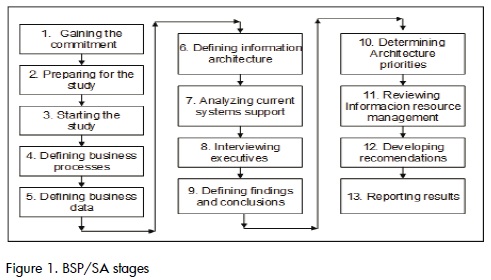
There are two stages of particular interest when applying BSP/SA methodology that are wasteful when done by hand: stage 4 and stage 6. In stage 4, process determination, once the processes have been identified and described, they are then related to organisational structure. For each organisational unit (when several dependencies in an organisation can be clustered), the degree of participation in decision- making is determined; the following conventions are used for this:

Once the degree of participation has been established, the processes vs organisation matrix (POM) is then analysed (Figure 2).
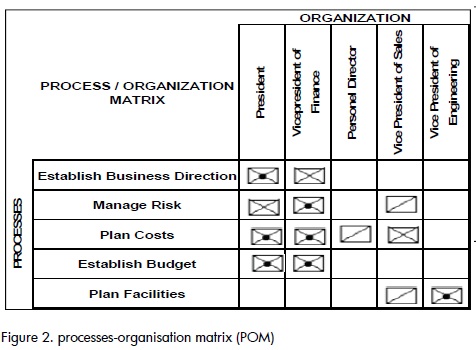
Certain abnormalities can be identified through this matrix related to processes such as repeated processes, overloading some dependencies and dependencies having low workload, processes with many directly responsible people or some processes without responsible people. The matrix leads to identifying which people must be interviewed within an organisation.
In stage 6 (determining information architecture), once data classes and the logical cluster of data related to entities that are important to the organisation have been identified and determined, the relationship between data classes and processes is established through the processes vs data classes matrix (PDM) (Figura 3).
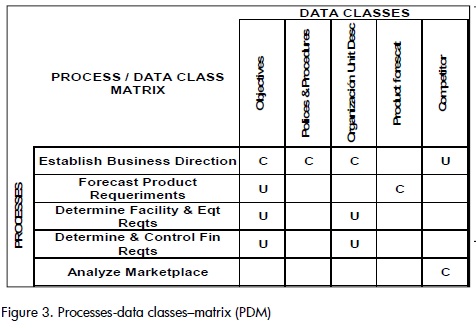
Each data class's relationship with the processes is determined using the following conventions: C, data class, created by the correspondding process; U, data class used by the corresponding process.
In principle, this matrix can be used for verifying that all data classes re-quired are present and that they have their origin in a single process. Now, taking the importance of POM and PDM matrices in BSP/SA methodology into account, integrating both matrices must be auto-mated since the analysis of informati
Methodology
The methodology used for developing this work took into account software development characteristics for supporting management in organisations (Rondon et al., 2007, Avila et al., 2008), BSP/SA stages(IBM, 1984) and specific software development (Kendall and Kendall, 1997). The stages included reviewing and analysing SISP and BSP/SA literature, semi-structured interviews with experts in the field to assess the statistical reports, testing the so-designed reports with certain matrices (Romero and Romero, 2003) and developing a computational tool, taking into account the system analysis and design approach using systems development life cycle (SDLC) emphasising analysis, design, implementation and use stages. The results obtained by automation were compared to those calculated in stage c to verify the correct running of the tool. The computational tool was developed in Visual Basic in Microsoft Office Excel environment to provide ease of use and take advantage of all editing abilities and the environment offered by this spreadsheet in conjunction with Visual Basic language.
Results
The tool allows a user to perform the following tasks:
- Enter the names and descriptions of processes taking place in an organisation;
- Enter the names and description of an organisation's groups of processes;
- Classify processes into the respective group process based on information entered by the user;
- Enter the names and description of a company's organisational units;
- Automatically create the POM based on process and organisational unit information entered by the user;
- Edit the POM's ruled columns establishing the degree of responsebility for each organisational unit in a process;
- Automatically generate reports defined by the POM;
- Enter the name and description of data classes identified and defined in the company;
- Arrange the processes in order to put strategic planning and management control first, then products and services in the life-cycle sequence and lastly processes for support resource management;
- Determine the process that creates each data classes based on information provided;
- Determine data classes used by each process based on information supplied;
- Automatically create the PDM based on information regarding pro-cesses, data classes and the creation and use of data classes ente-red by a user;
- Automatically generate reports defined by the PDM; and
- Define automated reports from the tool.
POM reports: processes having no directly responsible people in the organisational structure; company dependencies having no directly responsible people, at least, for a process; processes directed by more than one dependency (Figure 4).
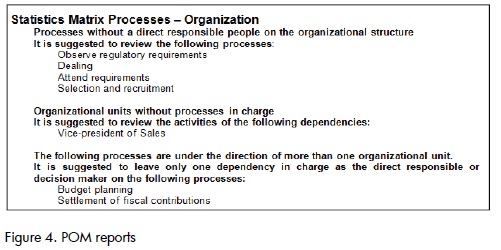
Prior reports allow a user to identify any abnormalities that should be analysed before proceeding with the methodology. Statistical analysis of the POM can then be carried on. The complementary statistical analysis reports of the POM can be viewed in Figure 5.
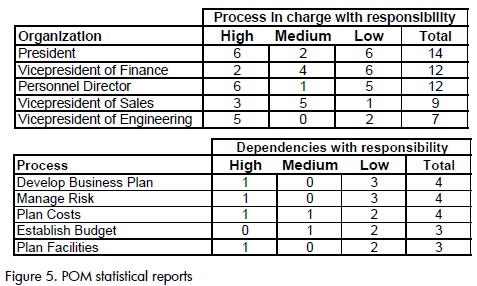
Statistical reports allow thorough analysis of the situation in an organisation regarding the relationship between its processes and dependencies, taking the level of responsibility (high, medium and low) into account.
Organisational performance reports: percentage participation of each company dependency in processes (Figure 6). Percentage participation of every dependency in the whole system (Figure 7).
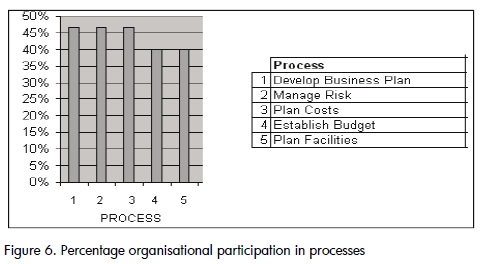
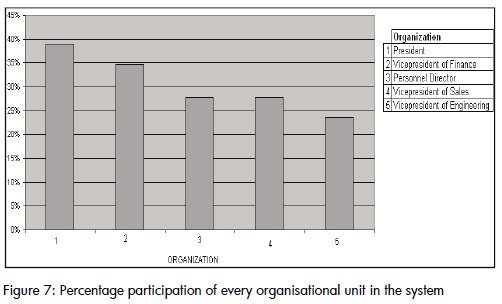
PDM reports: processes that do not use data classes, processes that do not create data classes, processes that do not create or use data classes, data classes that are not used in any process, data classes created by more than one process (Figure 8).
Prior reports allow a user to identify any abnormalities that should be analysed before proceeding with the methodology. PDM components can then be statistically analysed. Complementary PDM statistical analysis reports can be viewed in Figure 9
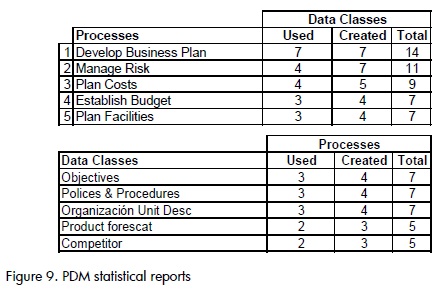
Statistical reports allow thorough analysis of the situation in an organisation regarding the relationship between processes and data classes, taking into account the property for using or creating data classes.
The tool and the user's manual can be loaded from the website: http://www.docentes.unal.edu.co/facortesa/docs/966/
Conclusions
Manual processes supporting critical steps in SISP implementation can be automated through methodologies and software development technologies.
Software products supporting SISP teaching and training can be created by means of interaction between systems engineers' skills and expertise and administrative knowledge.
BSP/SA methodology is known for proposing a proper analysis of process level of support for organisational units and data classes but does not take advantage of the qualitative and quantitative analysis associated with the matrices used.
It was very useful to apply basic statistical concepts analysing the matrix and conducting semistructured interviews with experts in the field.
Qualitative and quantitative reports, which can be applied to matrices proposed in BSP/SA, are based on identifying the empty rows and columns of each associated data structure
Software, as presented in this paper, has the following advantages: facilitating teaching and training in constructing POM and PDM,supporting the construction of POM and PDM and providing reports to accompany POM and the PDM analysis. The tool has the limitations inherent in the development tool (Visual Basic in Microsoft Office Excel environment).
POM and PDM are useful tools within SISP and their results are meant to be completed with results from other matrices, typical of BSP/SA methodology, such as process-clustered data classes matrix. The added value of the tool presented in this paper is the possibility of having a user-friendly software that can be used for teaching and training in constructing POM and PDM matrices in educational establishments and small and medium sized companies, without incurring higher costs. It is worth stating that it was of vital importance to follow a good methodology for analysis and design in developing the software before its implementation. The analysis stage and the design stages were the most difficult because the participation of several experts in the field was needed and the complexity of the project. Difficulties arising du-ring the implementation stage were due to technical problems which were solved thanks to the programming tool's good documentation and the work team's quality regarding computer programming training; the team's concern and motivation were fundamental in concluding the present work.
Ávila, O., Cortés, F., Ramírez, A. UNbizplanner: herramienta de software para preparar planes de negocios., Ingeniería e Investigación, 28, 1, 2008, pp. 154-161. [ Links ]
Basu, V., Hartono, E., Lederer, A.L., Sethi, V., The impact of organizational commitment, senior management involvement, and team involvement on strategic information systems planning., Information & Management, 39, 2002, pp. 513-524. [ Links ]
Benita, C., Accountability lost: the rise and fall of double entry., Omega, 31, 2003, pp. 303 - 310. [ Links ]
Chi, L., Jones, K.G., Lederer, A. L., Li, P., Newkirk, H. E., Sethi, V., Environmental assessment in strategic information systems planning., International Journal of Information Management, 25, 2005, pp. 253-269. [ Links ]
Duhan, S., A capabilities based toolkit for strategic information systems planning in SMEs., International Journal of Information Management, 27, 2007, pp. 352-367 [ Links ]
IBM Corporation, Information Systems Planning Guide., Atlanta Georgia: IBM publications, 1984, pp. 146. [ Links ]
Kearns, G.S., The effect of top management support of SISP on strategic IS management: insights from the USelectric power industry., The international Journal of Management Science, 34, 2006, pp. 236 - 253. [ Links ]
Kearns, G.S., Lederer, A.L., The effect of strategic alignment on the use of IS-based resources for competitive advantage., Journal of Strategic Information Systems, 9, 2000, pp. 265-293. [ Links ]
Kendall, K.E., Kendall J.E. Análisis y Diseño de Sistemas., México: Prentice Hall, 1997. 913 p. [ Links ]
King, W.R., Teo, T.S.H., Assessing the impact of proactive versus reactive modes of strategic information systems planning., Omega 28, 2000, pp. 667-679 [ Links ]
Kunnathur, A. S., Shi, Z., An investigation of the strategic information systems planning success in Chinese publicly traded firms., International Journal of Information Management, 21, 2001, pp. 423-439. [ Links ]
Lederer, A. L., Salmela, H., Toward a theory of strategic information systems planning., Journal of Strategic Information Systems, 5, 1996, pp. 237-253. [ Links ]
Lee, H.S., Theory and Methodology. Automatic clustering of business processes in business systems planning., European Journal of Operational Research, 114, 1999 pp. 354-362. [ Links ]
Mohdzain, M. B., Ward, J. M., A study of subsidiaries' views of information systems strategic planning in multinational organizations., Journal of Strategic Information Systems, 16, 2007, pp. 324-352. [ Links ]
Newkirk, H. E., Lederer, A L., The effectiveness of strategic information systems planning under environmental uncertainty., Information & Management, 43, 2006 pp. 481-501. [ Links ]
Newkirk, H. E., Lederer A.L., Srinivasan C., Strategic information systems planning: too little or too much?, Journal of Strategic Information Systems, 12, 2003, pp. 201-228. [ Links ]
Pant, S., Taek H., Hsu, Ch., A framework for developing Web information systems plans: illustration with Samsung Heavy Industries Co., Ltd. Information & Management, 38, 2001, pp. 385-408. [ Links ]
Romero, S.A., Romero, J.M., Desarrollo de un plan estratégico de informática para la Facultad de Odontología., Tesis presentada en la Universidad Nacional de Colombia, sede Bogotá, para optar al grado de Ingeniero de Sistemas, 2003. [ Links ]
Rondón, J., Cortés, F., Zarate, E., Enterprise - process: aplicación basada en computador para obtener la matriz proceso - organización durante la planeación estratégica de sistemas de información., Ingeniería e Investigación, 27, 3, 2007, pp. 203-209. [ Links ]
Teo, T.S.H., Ang J.S.K., Critical success factors in the alignment of IS plans with business plans., International Journal of Information Management, 19, 1999, pp. 173-185. [ Links ]
Teubner, Strategic information systems planning: A case study from the financial services industry., Journal of Strategic Information Systems, 16, 2007, pp. 105-125. [ Links ]
Ward, J., Peppard J., Strategic planning for information systems., 3rd ed. New York: Wiley, 2002. [ Links ]











 texto en
texto en 


